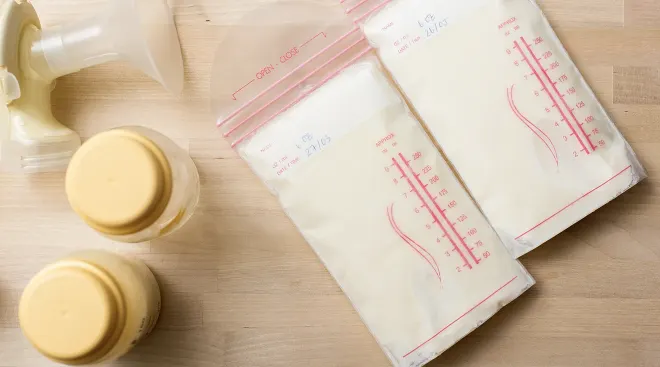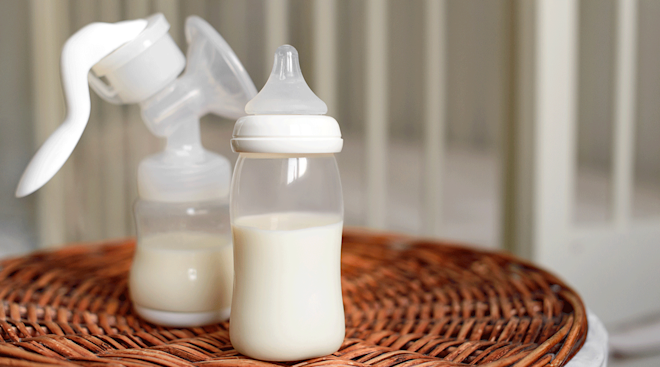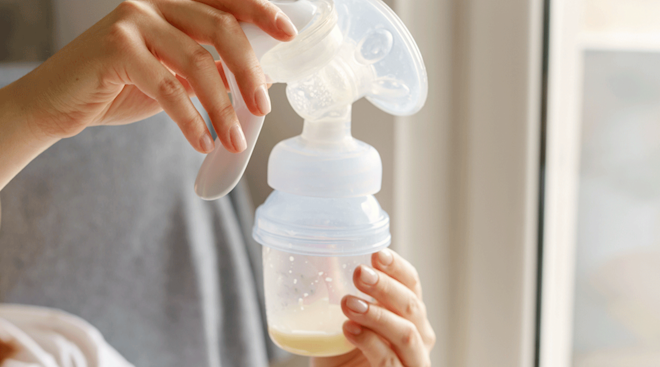Why You Might Consider Power Pumping (and How to Do It)
If you’ve ever struggled with low milk supply, you know that it can make breastfeeding baby more stressful than you ever imagined it’d be—particularly if you’re committed to maintaining a breast milk-only diet during the first few months of their life. When it comes to increasing milk production, power pumping is one strategy that some breastfeeding parents swear by. Here’s an overview of how it works, plus some expert tips to help you get the best results from your power pump sessions.
Power pumping is a technique in which a lactating parent pumps frequently within a short period of time, mimicking a baby cluster feeding at the breast, explains Margot Hodes, IBCLC, a lactation consultant based in New York City. “The goal is to stimulate the production of prolactin, the major milk-making hormone,” she says.
“Every time we remove milk from the breast, we’re telling our body we need to make more milk,” adds Shelly Patularu, RN, IBCLC, a lactation consultant in Detroit. Whether it’s through nursing or pumping, “frequent emptying in a short interval will result in an increase in milk supply.”
Going back to work, ditching night feedings or any other change that finds you feeding and/or pumping less frequently can result in a dip in output, but power pumping may help spike it back up. If you’ve had a healthy milk supply previously, Hodes says, “you’ll probably respond well to power pumping, because you already know that a lot of the glandular tissue is working well.”
Patularu adds that breastfeeding twins or triplets is another big reason to consider power pumping. “Initially, it’s to tell [your] body that [you] need enough milk for two or three babies,” she explains.
Of course, power pumping isn’t always the right answer. Patularu notes that it’s not necessary for those with an ample supply—and those with mastitis or clogged ducts shouldn’t try power pumping. Additionally, Hodes cautions against power pumping if you’re experiencing significant depression or anxiety. “Often, a person who is struggling with their milk supply is also really stressed out and sleep deprived,” she says. “Adding more work is the last thing they need.”
The only true difference between regular pumping and power pumping is the timetable. Remember: The technique is modeled after an infant’s cluster feeding. “When baby is in the newborn period, for example, a person might pump about eight times a day,” Hodes says. “Power pumping is about more frequent pumping in a shorter period of time.”
Blocking off your entire day to power pump isn’t necessary—just make sure one of your daily sessions is dedicated to power pumping, and follow a schedule that works for your family.
Sample power pumping schedule
As noted by both Patularu and Hodes, a popular one-hour power pumping schedule goes as follows:
- Pump for 20 minutes
- Rest for 10 minutes
- Pump for 10 minutes
- Rest for 10 minutes
- Pump for 10 minutes
“When you’re caring for a newborn—or two, even three newborns—it’s not always possible to do a full 60-minute session,” Patularu says. To that end, she likes to offer a modified 30-minute power pumping schedule to effectively halve the time:
- Pump for 10 minutes
- Rest for 5 minutes
- Pump for 5 minutes
- Rest for 5 minutes
- Pump for 5 minutes
Alternately, you can try pumping for 10 minutes, resting for 50 minutes and repeating that two more times (ultimately pumping 10 minutes an hour for three hours). “This one is for families who are trying to nurse mainly at the breast, not for those pumping exclusively,” Patularu explains. “If you pump exclusively, and your regularly scheduled pumping session falls within that time, you can just pump for an extra 10 minutes,” she adds.
So what’s the ideal time of day for power pumping? “Whenever you can,” Patularu says It’s best to let your needs and those of baby guide you. In terms of peak milk production, “in the early morning hours, it’s very high,” Hodes says—so right after the first morning feed may yield the most results.
Ready to give power pumping a try? Here are some tips to help you get started:
- Use a double-electric pump. A hand pump isn’t made for power pumping. “Don’t give yourself carpal tunnel,” Patularu says.
- Make sure your flanges are correctly sized. “A pump works on suction alone, and one that doesn’t fit won’t properly empty the breast,” says Patularu.
- Drink plenty of water. Staying hydrated is essential to keeping your milk supply up.
- Ask for an extra pair of hands. Hodes suggests trying your first power pump session on a weekend, when a co-parent, friend or family member can be there to care for baby while you’re hooked up.
- Prime your pumping station. In addition to your fuel (drinks and snacks!), light a scented candle, use a foot massager and enjoy a good book or favorite show. In other words, try to make pumping a pleasant and relaxing experience, rather than a chore.
- Keep baby “close.” Hodes suggests sniffing a baby-scented article of your little one’s clothing, and gazing at a photo of them to encourage letdown.
- Try the baby sock trick. Agonizing over a slow drip as you watch your pump can create a vicious circle of stress, so Patularu recommends placing a sock over each bottle so you simply can’t see them.
- Finish the session. Even if the effort feels fruitless or you only see a few drops, keep going. Patularu recommends power pumping for four to seven days. It may take time to get results.
If you don’t notice any increase in supply after about a week, you may want to reach out to a lactation consultant to investigate possible other causes.
Above all else, give yourself a lot of grace. You’re a dedicated parent doing your best to feed your child. “Breastfeeding is a relationship between you and baby, and it has to work for both of you,” says Hodes. “Your emotional and physical well-being are just as important as anything else.”
Please note: The Bump and the materials and information it contains are not intended to, and do not constitute, medical or other health advice or diagnosis and should not be used as such. You should always consult with a qualified physician or health professional about your specific circumstances.
Plus, more from The Bump:
Margot Hodes, MA, IBCLC, CCCE, CHES, is a childbirth educator, lactation consultant and newborn specialist based in New York City.
Shelly Patularu, RN, IBCLC, is a lactation consultant in Detroit.
Learn how we ensure the accuracy of our content through our editorial and medical review process.
Navigate forward to interact with the calendar and select a date. Press the question mark key to get the keyboard shortcuts for changing dates.




















































